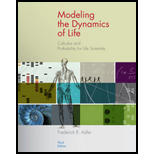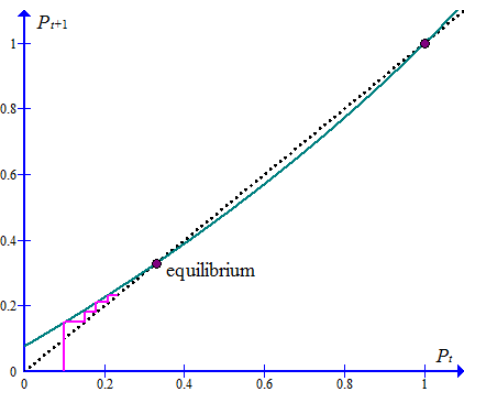
a
To calculate: To find the number of wild-type bacteria that mutates using the given information
a
Answer to Problem 32E
The number of wild-type bacteria that mutate is
Explanation of Solution
Given information: Suppose that a fraction 0.2 of wild-type mutate each generation, but that each wild-type individual produces 2.0 offspring while each mutant produces only 1.0 offspring.
Calculation:
Initially, let there be
Now a fraction 0.2 of wild-type mutate each generation.
Therefore, the number of wild-type bacteria that mutate is
b
To calculate: To find the number of wild-type bacteria and the number of mutants after mutation using the given information
b
Answer to Problem 32E
The number of mutants after mutation is given by
Explanation of Solution
Given information: Suppose that a fraction 0.2 of wild-type mutate each generation, but that each wild-type individual produces 2.0 offspring while each mutant produces only 1.0 offspring.
Calculation:
Now the number of wild type bacteria after mutation is given by
Also, the number of mutants after mutation is given by
c
To calculate: To find the number of wild-type bacteria and the number of mutants after reproduction using the given information
c
Answer to Problem 32E
Therefore, the number of mutants after reproduction shall be
Explanation of Solution
Given information: Suppose that a fraction 0.2 of wild-type mutate each generation, but that each wild-type individual produces 2.0 offspring while each mutant produces only 1.0 offspring.
Calculation:
Now, each wild-type individual produces 2.0 offspring.
Therefore, the number of wild-type bacteria after reproduction is given by
Also, each mutant produces only 1.5 offspring.
Therefore, the number of mutants after reproduction shall be
d
To calculate: To find the total number of bacteria after mutation and reproduction using the given information
d
Answer to Problem 32E
The total number of bacteria after mutation and reproduction is given by
Explanation of Solution
Given information: Suppose that a fraction 0.2 of wild-type mutate each generation, but that each wild-type individual produces 2.0 offspring while each mutant produces only 1.0 offspring.
Calculation:
The total number of bacteria after mutation and reproduction is given by
e
To calculate: To find the fraction of mutants after mutation and reproduction using the given information
e
Answer to Problem 32E
Explanation of Solution
Given information: Suppose that a fraction 0.2 of wild-type mutate each generation, but that each wild-type individual produces 2.0 offspring while each mutant produces only 1.0 offspring.
Calculation:
To find the fraction of mutants after mutation and reproduction, divide the discrete-time dynamical system for
Therefore, we have
f
To calculate: To find the equilibrium using the obtained values
f
Answer to Problem 32E
Explanation of Solution
Given information: Suppose that a fraction 0.2 of wild-type mutate each generation, but that each wild-type individual produces 2.0 offspring while each mutant produces only 1.0 offspring.
Calculation:
Let
To find the equilibrium consider,
Solving the above equation gives,
Therefore,
g
To calculate: To determine and to find whether the equilibrium is stable or not using the obtained information
g
Answer to Problem 32E
The fraction of mutants will end up at about 33.33 percent.
Explanation of Solution
Given information: Suppose that a fraction 0.2 of wild-type mutate each generation, but that each wild-type individual produces 2.0 offspring while each mutant produces only 1.0 offspring.
Calculation:
The cobweb starting from the initial condition is as shown below:

The equilibrium at l/ 3 seems to be stable. The fraction of mutants will end up at about 33.33 percent.
Want to see more full solutions like this?
Chapter 1 Solutions
Modeling the Dynamics of Life: Calculus and Probability for Life Scientists
- 3. (a) Lety: [a, b] C be a contour. Let L(y) denote the length of y. Give a formula for L(y). (1 mark) (b) Let UCC be open. Let f: U→C be continuous. Let y: [a,b] → U be a contour. Suppose there exists a finite real number M such that |f(z)| < M for all z in the image of y. Prove that < ||, f(z)dz| ≤ ML(y). (3 marks) (c) State and prove Liouville's theorem. You may use Cauchy's integral formula without proof. (d) Let R0. Let w € C. Let (10 marks) U = { z Є C : | z − w| < R} . Let f UC be a holomorphic function such that 0 < |ƒ(w)| < |f(z)| for all z Є U. Show, using the local maximum modulus principle, that f is constant. (6 marks)arrow_forward3. (a) Let A be an algebra. Define the notion of an A-module M. When is a module M a simple module? (b) State and prove Schur's Lemma for simple modules. (c) Let AM(K) and M = K" the natural A-module. (i) Show that M is a simple K-module. (ii) Prove that if ƒ € Endд(M) then ƒ can be written as f(m) = am, where a is a matrix in the centre of M, (K). [Recall that the centre, Z(M,(K)) == {a Mn(K) | ab M,,(K)}.] = ba for all bЄ (iii) Explain briefly why this means End₁(M) K, assuming that Z(M,,(K))~ K as K-algebras. Is this consistent with Schur's lemma?arrow_forward(a) State, without proof, Cauchy's theorem, Cauchy's integral formula and Cauchy's integral formula for derivatives. Your answer should include all the conditions required for the results to hold. (8 marks) (b) Let U{z EC: |z| -1}. Let 12 be the triangular contour with vertices at 0, 2-2 and 2+2i, parametrized in the anticlockwise direction. Calculate dz. You must check the conditions of any results you use. (d) Let U C. Calculate Liz-1ym dz, (z - 1) 10 (5 marks) where 2 is the same as the previous part. You must check the conditions of any results you use. (4 marks)arrow_forward
- (a) Suppose a function f: C→C has an isolated singularity at wЄ C. State what it means for this singularity to be a pole of order k. (2 marks) (b) Let f have a pole of order k at wЄ C. Prove that the residue of f at w is given by 1 res (f, w): = Z dk (k-1)! >wdzk−1 lim - [(z — w)* f(z)] . (5 marks) (c) Using the previous part, find the singularity of the function 9(z) = COS(πZ) e² (z - 1)²' classify it and calculate its residue. (5 marks) (d) Let g(x)=sin(211). Find the residue of g at z = 1. (3 marks) (e) Classify the singularity of cot(z) h(z) = Z at the origin. (5 marks)arrow_forward1. Let z = x+iy with x, y Є R. Let f(z) = u(x, y) + iv(x, y) where u(x, y), v(x, y): R² → R. (a) Suppose that f is complex differentiable. State the Cauchy-Riemann equations satisfied by the functions u(x, y) and v(x,y). (b) State what it means for the function (2 mark) u(x, y): R² → R to be a harmonic function. (3 marks) (c) Show that the function u(x, y) = 3x²y - y³ +2 is harmonic. (d) Find a harmonic conjugate of u(x, y). (6 marks) (9 marks)arrow_forwardLet A be a vector space with basis 1, a, b. Which (if any) of the following rules turn A into an algebra? (You may assume that 1 is a unit.) (i) a² = a, b² = ab = ba = 0. (ii) a²=b, b² = ab = ba = 0. (iii) a²=b, b² = b, ab = ba = 0.arrow_forward
- No chatgpt pls will upvotearrow_forward= 1. Show (a) Let G = Z/nZ be a cyclic group, so G = {1, 9, 92,...,g" } with g": that the group algebra KG has a presentation KG = K(X)/(X” — 1). (b) Let A = K[X] be the algebra of polynomials in X. Let V be the A-module with vector space K2 and where the action of X is given by the matrix Compute End(V) in the cases (i) x = p, (ii) xμl. (67) · (c) If M and N are submodules of a module L, prove that there is an isomorphism M/MON (M+N)/N. (The Second Isomorphism Theorem for modules.) You may assume that MON is a submodule of M, M + N is a submodule of L and the First Isomorphism Theorem for modules.arrow_forward(a) Define the notion of an ideal I in an algebra A. Define the product on the quotient algebra A/I, and show that it is well-defined. (b) If I is an ideal in A and S is a subalgebra of A, show that S + I is a subalgebra of A and that SnI is an ideal in S. (c) Let A be the subset of M3 (K) given by matrices of the form a b 0 a 0 00 d Show that A is a subalgebra of M3(K). Ꮖ Compute the ideal I of A generated by the element and show that A/I K as algebras, where 0 1 0 x = 0 0 0 001arrow_forward
- (a) Let HI be the algebra of quaternions. Write out the multiplication table for 1, i, j, k. Define the notion of a pure quaternion, and the absolute value of a quaternion. Show that if p is a pure quaternion, then p² = -|p|². (b) Define the notion of an (associative) algebra. (c) Let A be a vector space with basis 1, a, b. Which (if any) of the following rules turn A into an algebra? (You may assume that 1 is a unit.) (i) a² = a, b²=ab = ba 0. (ii) a² (iii) a² = b, b² = abba = 0. = b, b² = b, ab = ba = 0. (d) Let u1, 2 and 3 be in the Temperley-Lieb algebra TL4(8). ገ 12 13 Compute (u3+ Augu2)² where A EK and hence find a non-zero x € TL4 (8) such that ² = 0.arrow_forwardQ1: Solve the system x + x = t², x(0) = (9)arrow_forwardBetween the function 3 (4)=x-x-1 Solve inside the interval [1,2]. then find the approximate Solution the root within using the bisection of the error = 10² method.arrow_forward
 Linear Algebra: A Modern IntroductionAlgebraISBN:9781285463247Author:David PoolePublisher:Cengage Learning
Linear Algebra: A Modern IntroductionAlgebraISBN:9781285463247Author:David PoolePublisher:Cengage Learning

